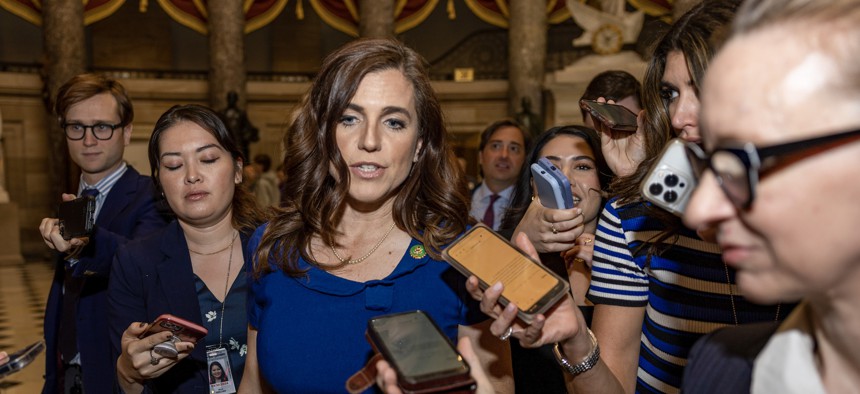Tech subcommittee chairwoman plans MGT Act rewrite

Rep. Nancy Mace (R-S.C.) shown here talking to reporters in the Capitol in April, announced plans to update the Modernizing Government Technology Act. Tasos Katopodis/Getty Images
Rep. Nancy Mace (R-S.C.) said at a hearing that the congressionally-mandated revolving fund for tech upgrades is "a tool that needs sharpening."
Rep. Nancy Mace (R-S.C.), the new chairwoman of a House subcommittee focused on technology, said she planned to draft legislation to reform the Technology Modernization Fund with guidance from the recommendations provided by experts at a Wednesday hearing. The fund was established in 2017 by the Modernizing Government Technology Act.
Mace said the fund, which supports cross-agency IT modernization projects, initially provided the government with "another tool for replacing legacy IT, but it's become clear that it's a tool that needs sharpening."
"I intend to introduce legislation soon that will do just that," she said, without providing further details.
The TMF board has so far approved 40 projects across 24 federal agencies, totaling nearly $713 million, after receiving a $1 billion plus-up through the American Rescue Plan Act. But some agencies "had yet to realize any cost savings" for numerous TMF projects "and continued to use unreliable cost estimates," said Kevin Walsh, director of IT and cybersecurity for the Government Accountability Office, at a hearing of the Cybersecurity, Information Technology and Government Innovation Subcommittee of the House Committee on Oversight and Accountability.
Federal legacy IT systems are jeopardizing critical government missions as agencies continue failing to take aggressive action to replace outdated technology, experts warned in testimony.
"We all understand what's at stake here: Critical federal systems are operating with known security vulnerabilities and unsupported hardware and software,” said Dave Powner, executive director of the nonprofit MITRE's Center for Data-Driven Policy. “Despite recent calls for action on our nation's critical legacy systems, the federal government's plans, budgets and actions are not where they need to be."
The federal government has been pouring hundreds of millions of dollars annually into critical federal IT legacy systems: A 2019 report identified 10 outdated federal IT systems that collectively cost nearly $337 million to operate and maintain. But funding obsolete and costly systems has not resulted in an improved cyber posture for most agencies.
Instead, the outcome has been increased costs that are "linked to security risks, unmet mission needs and staffing issues," Walsh testified. "In an era of constrained budgets, the high costs of maintaining legacy systems could limit agencies’ ability to modernize and develop new or replacement systems," he added.
Suzette Kent, CEO of Kent Advisory Services and former federal chief information officer, called on Congress to update one of the various scoring methods used to track governmentwide progress on modernization efforts, including the Federal Information Technology Acquisition Reform Act , the federal IT dashboard, or to potentially create new measures "to bring laser focus to agency progress eliminating outdated technology."
Congress passed FITARA in 2014 to help improve agencies' IT management through enhanced CIO authorities and improved oversight of IT investments. Mace said the legislation that the subcommittee plans will address agency modernization efforts and the need for the federal government to transition away from outdated technology and obsolete systems.



